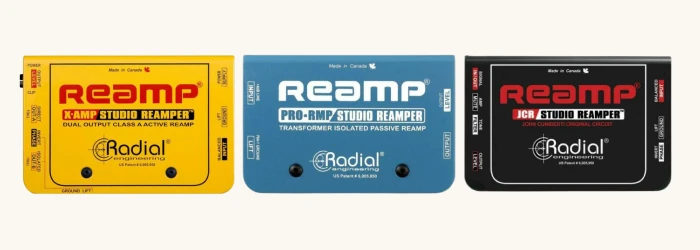I’m sure you’ve heard about reamp boxes. A little magical box that helps you with reamping guitars or other instruments.
If you are new to recording there is a big chance that you don’t know what it is and what it does. But don’t be afraid because I’m going to tell you every detail about reamp boxes.
In this post, you will learn what a reamp box is, what it does, and how it works. So, let’s get started.
What Is A Reamp Box?
In simple words, a reamp box is an audio converter that converts a balanced, low-impedance signal to an unbalanced, high-impedance signal. And it can be useful for many reasons.
The main features of it are input and output and that’s all you need to start reamping. And there are many great reamp boxes with additional features.
It’s that simple. The reamp box just covers the sound but the important thing is what you can do with it. That becomes apparent when you want to reamp your instruments.
Also, it’s important to know that this device does the opposite of what a DI box does. A DI box converts an unbalanced signal to a balanced signal. Many people think that they are the same but it’s not true.
Reamp Box Types

You might see different reamp boxes and think that there are various types of boxes that do different things but that’s not true.
Although various reamp boxes exist all of them do the same thing. They all have inputs and outputs however some of them may offer filters, level control, polarity, etc. But they all do the same thing.
However, there are passive and active reamp boxes that work the same way but have slight differences.
For example, passive reamp boxes use transformers and don’t require a power source. On the other hand, active reamp boxes are brighter and clear and offer hum canceling.
I have used both types and to be honest, didn’t notice any difference and had no issues. So, get any type of reamp box and you will be fine.
What Is Reamping?
Before I explain how reamp boxes work it’s important to know what reamping is and how it works because it will help you understand better. And the main purpose of a reamp box is reamping.
Reamping means when you have a DI track of a guitar for example and you connect it to a guitar amp of your choice with the help of a reamp box. Then you can just press record and it will record the same DI track but with the amp sound, you have connected it to.
The benefit of reamping is that you can record guitar or bass without worrying about the tone. Just focus on the playing quality and you can choose any tone you like later.
How Does A Reamp Box Work?
Now you understand what a reamp box is, how it works, and what reamping means. Now it’s time to learn how exactly a reamp box works and how to connect it to your DAW and an amp.
Every audio interface has balanced outputs and you connect it to a reamp box through these outputs. The output from the audio interface goes into the input of the reamp box.
For that, you will need a cable that has an XLR jack on one end to connect it to the device’s input.
After that connect the output of the reamp box to the guitar or bass amplifier input with a standard guitar cable and that’s it. The connection is complete and you can start reamping.
For more clarity here is the simple visualization about the reamp box connection.

After that, you can create a new track, set its input to the microphone you use for the amplifier, switch the record mode on for that track, and press the record button.
And it will record the DI track but with the amp sound. Of course, you can listen to the tone, tweak your amp, and when you are satisfied you can record again.
And that’s the power of reamp boxes and reamping in general. You record your instruments and worry about tones later.
Conclusion
Reamp boxes are great tools for recording especially in a home studio because they make the recording process much easier. Reamping gives you the ability to focus on the recording and choose the tones and sounds later. Also, it allows you to try different amps which will help you to choose the best sound for the instrument.
